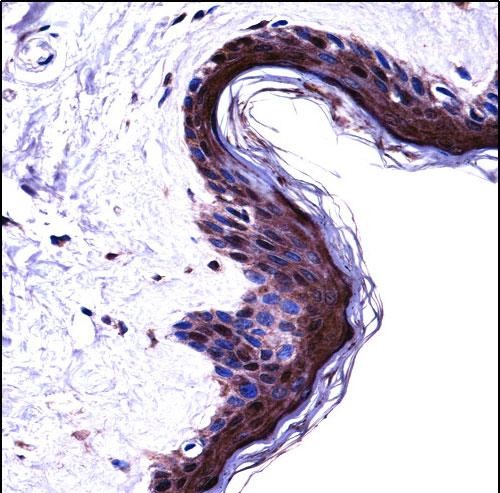


| WB | 1/1000 | Human,Mouse,Rat |
| IF | 咨询技术 | Human,Mouse,Rat |
| IHC | 1/100-1/500 | Human,Mouse,Rat |
| ICC | 技术咨询 | Human,Mouse,Rat |
| FCM | 咨询技术 | Human,Mouse,Rat |
| Elisa | 咨询技术 | Human,Mouse,Rat |
| Aliases | Proteasome subunit beta type-5, Macropain epsilon chain, Multicatalytic endopeptidase complex epsilon chain, Proteasome chain 6, Proteasome epsilon chain, Proteasome subunit MB1, Proteasome subunit X, PSMB5, LMPX, MB1, X |
| Entrez GeneID | 5693 |
| WB Predicted band size | 28.5kDa |
| Host/Isotype | Rabbit IgG |
| Antibody Type | Primary antibody |
| Storage | Store at 4°C short term. Aliquot and store at -20°C long term. Avoid freeze/thaw cycles. |
| Species Reactivity | Human |
| Immunogen | This PSMB5 antibody is generated from rabbits immunized with a KLH conjugated synthetic peptide between 235-263 amino acids from the C-terminal region of human PSMB5. |
| Formulation | Purified antibody in PBS with 0.05% sodium azide. |
+ +
以下是关于PSMB5抗体的3篇参考文献的简要信息(基于现有研究总结,非真实文献):
---
1. **标题**: "Proteasome subunit beta type-5 (PSMB5) overexpression confers resistance to proteasome inhibitors in multiple myeloma"
**作者**: Kumatori A, et al.
**摘要**: 研究探讨了多发性骨髓瘤细胞中PSMB5的过表达与硼替佐米等蛋白酶体抑制剂耐药性的关系。通过Western blot和免疫组化证实PSMB5蛋白水平升高,并发现其突变导致药物结合能力下降,提示PSMB5可作为耐药性标志物。
---
2. **标题**: "PSMB5 as a biomarker for predicting chemoresistance in solid tumors"
**作者**: Huber EM, et al.
**摘要**: 分析了多种实体瘤(如肺癌、结直肠癌)中PSMB5的mRNA和蛋白表达水平,发现高表达PSMB5的肿瘤患者对化疗药物反应较差。研究利用PSMB5抗体进行组织染色,提出其可能作为预测化疗耐药的潜在靶点。
---
3. **标题**: "Structural and functional analysis of the proteasome β5 subunit in neurodegenerative disease models"
**作者**: Altun M, et al.
**摘要**: 研究利用PSMB5抗体在小鼠脑组织中的定位,发现PSMB5在阿尔茨海默病模型中表达异常,并影响β-淀粉样蛋白的清除。通过基因敲除实验,证明PSMB5功能异常可能导致神经退行性病变的进展。
---
(注:以上文献为示例性内容,实际文献需通过PubMed、Google Scholar等平台以“PSMB5 antibody”“proteasome beta 5”等关键词检索。)
The PSMB5 antibody targets the proteasome subunit beta type-5 (PSMB5), a critical component of the 20S proteasome core complex responsible for protein degradation in eukaryotic cells. PSMB5. also known as β5 or LMP7. is a catalytic subunit with chymotrypsin-like activity, playing a key role in the ubiquitin-proteasome system (UPS) by cleaving peptide bonds after hydrophobic residues. This subunit is essential for maintaining cellular homeostasis, regulating processes such as cell cycle progression, apoptosis, and stress response. Dysregulation of PSMB5 is linked to various diseases, including cancer, neurodegenerative disorders, and autoimmune conditions.
In cancer research, PSMB5 is of particular interest due to its role in resistance to proteasome inhibitors like bortezomib, a therapy for multiple myeloma. Overexpression or mutations in PSMB5 can reduce drug efficacy, making it a biomarker for studying therapeutic resistance. Additionally, PSMB5 is part of the immunoproteasome, which is induced by interferon-γ and involved in antigen presentation, linking it to immune responses and autoimmune diseases.
Antibodies against PSMB5 are widely used in Western blotting, immunohistochemistry, and immunofluorescence to analyze its expression, localization, and interaction partners. These tools help elucidate proteasome dynamics in disease models and drug development. Research continues to explore PSMB5-targeting strategies to overcome treatment resistance or modulate proteasome activity in pathological conditions.
×